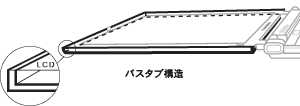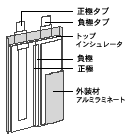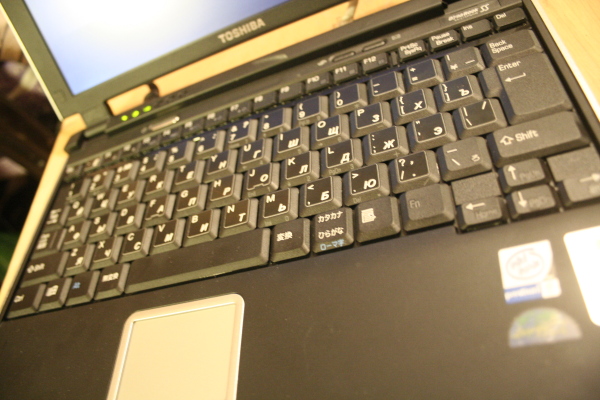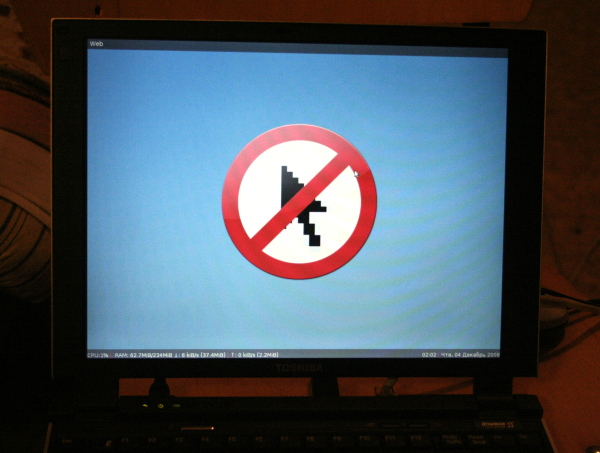Tale of Big Brother: Linux OS on Toshiba Portege SS S4 / 275PNHW
After a three-day struggle with the baby Libretto, I got up from the right foot and went to work. Standing in the subway car, I was thinking about my failures ... and it dawned on me, I once saw a useless laptop at work;) and not try to revive it;)
Having come to work, I reported my thoughts to the management. After lunch, I got Toshiba Portege SS S4 / 275PNHW, but then I didn’t know what to expect!

Half a day I was waiting for a miracle: installed Linux on an almost normal 2002 laptop. So let's see what kind of device it is.
This laptop belongs to the series Portege 2001 and is called DynaBook. There are very few descriptions of this device on the Internet.
This laptop is lightweight and very pleasant ergonomics.

Inside is:
Toshiba MK400GAH HDD to 40GB 1.8 ”

256 MB SDRAM, PIII 750 Mhz
This series has a very thin LCD screen.

and a powerful small Li-ion battery

There are also two ports USB, WiFi, SD-card reader, PCMCIA slot
Summary table:
Together with the laptop I got USB Floppy (Noname), USB CD-ROM MiniCD Archos.
After inserting the disc and running the machine, I realized that the boot from the CD-ROM does not work ... But I still had a flop, after I had done the floppy installation method I had already tried, I saw the familiar inscription that floppy was not found.
But there is also network boot (PXE)! So this is the only way at the moment.
So proceed to install on PXE.
First you need to connect the laptop to the network.

Next, on a Linux machine, you need to configure DHCP and TFTP servers.
You must first install them in ubuntu.
')
Next, you need to configure the DHCP server:
And tftp-hpa
In the / var / lib / tftpboot folder, unpack netinstall.tar.gz from the Ubuntu archive
Everything! The servers are now configured to connect from the client, set up the network download on the laptop and start! and get the installation download! Then I think everything is clear;)

It is a pity that this laptop is from Japan and there is little that can be found about it on the Internet, you have to do everything at random ...

Having come to work, I reported my thoughts to the management. After lunch, I got Toshiba Portege SS S4 / 275PNHW, but then I didn’t know what to expect!

Description
Half a day I was waiting for a miracle: installed Linux on an almost normal 2002 laptop. So let's see what kind of device it is.
This laptop belongs to the series Portege 2001 and is called DynaBook. There are very few descriptions of this device on the Internet.
This laptop is lightweight and very pleasant ergonomics.

Inside is:
Toshiba MK400GAH HDD to 40GB 1.8 ”

256 MB SDRAM, PIII 750 Mhz
This series has a very thin LCD screen.

and a powerful small Li-ion battery

There are also two ports USB, WiFi, SD-card reader, PCMCIA slot
Summary table:
| PM | ALi 7101 Power Management Controller |
| Sound | ALi Audio Accelerator WDM Driver |
| Modem | TOSHIBA Software Modem AMR |
| Hdc | ALi M5229 PCI Bus Master IDE Controller |
| HDD | MK400GAH |
| Video | Trident Video Accelerator CyberBlade XP Ai1 |
| Monitor | Toshiba Internal 1024x768 Panel |
| Irda | ALi Serial Infrared Controller |
| Mouse | Alps PointiFailed-device |
| PCMCIA | Toshiba ToPIC100 CardBus Controller |
| LAN | Intel 8255x-based PCI Ethernet Adapter (10/100) |
| WiFi | Melco AIRCONNECT WLI-PCM-L11 |
| USB | NEC PCI to USB Open Host Controller x2 |
| SDC | TOSHIBA SD Card Controller Type-A |
OS installation
Together with the laptop I got USB Floppy (Noname), USB CD-ROM MiniCD Archos.
After inserting the disc and running the machine, I realized that the boot from the CD-ROM does not work ... But I still had a flop, after I had done the floppy installation method I had already tried, I saw the familiar inscription that floppy was not found.
But there is also network boot (PXE)! So this is the only way at the moment.
So proceed to install on PXE.
First you need to connect the laptop to the network.

Next, on a Linux machine, you need to configure DHCP and TFTP servers.
Server setup
You must first install them in ubuntu.
apt-get install tftpd-hpa
apt-get install dhcp3-server
mkdir -p / var / www / ubuntu-606-server-i386 /
mount -o loop /dl/ubuntu-6.06-server-i386.iso / var / www / ubuntu-606-server-i386 /
tar xzvf /dl/netboot.tar.gz -C / var / lib / tftpboot
')
Next, you need to configure the DHCP server:
/etc/dhcp3/dhcpd.conf
ddns-update-style none;
option domain-name "hifichoice.com";
option domain-name-servers 83.146.21.6, 212.158.248.5;
ping-check = 1;
default-lease-time 600;
max-lease-time 7200;
log facility local7;
subnet 192.168.95.0 netmask 255.255.255.0 {
range 192.168.95.100 192.168.95.150;
option routers 192.168.95.1;
filename = "pxelinux.0";
next-server 192.168.95.20;
}
And tftp-hpa
/ etc / default / tftpd-hpa
RUN_DAEMON = “yes”
OPTIONS = "- l -s / var / lib / tftpboot"
In the / var / lib / tftpboot folder, unpack netinstall.tar.gz from the Ubuntu archive
Everything! The servers are now configured to connect from the client, set up the network download on the laptop and start! and get the installation download! Then I think everything is clear;)

PS
It is a pity that this laptop is from Japan and there is little that can be found about it on the Internet, you have to do everything at random ...
Good luck to all in the revival of iron;)

Source: https://habr.com/ru/post/46122/
All Articles